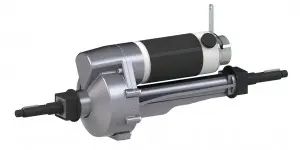How Does the Electric Transaxle Reduce Maintenance Costs Compared to ICE Vehicles?
Introduction
In the rapidly evolving automotive industry, the transition from Internal Combustion Engine (ICE) vehicles to Electric Vehicles (EVs) is gaining momentum. One of the key factors driving this shift is the significant reduction in maintenance costs associated with electric transaxles compared to traditional ICE vehicles. This blog post will delve into the various ways in which electric transaxles contribute to lower maintenance costs, making them an attractive option for international wholesale procurement.
1. Fewer Moving Parts
One of the most significant advantages of electric transaxles is their simplicity in design. Unlike ICE vehicles, which have hundreds to thousands of moving parts, electric transaxles contain far fewer components. This reduction in complexity leads to several benefits:
Less Wear and Tear: With fewer moving parts, there is less friction and wear over time. This means fewer parts need to be replaced or repaired.
Fewer Points of Failure: The reduced number of components means fewer potential points of failure, leading to higher reliability and lower repair costs.
Lower Maintenance Frequency: The simplicity of the electric transaxle means that maintenance intervals can be extended, reducing the overall maintenance burden.
2. Regenerative Braking Systems
Electric vehicles equipped with electric transaxles often feature regenerative braking systems. This technology not only helps to recharge the battery but also reduces the wear on traditional friction brakes. As a result:
Extended Brake Life: Brake pads and rotors last significantly longer, reducing the frequency of replacements.
Lower Brake Maintenance Costs: The reduced wear on the brake system translates into lower maintenance costs associated with brake repairs.
3. No Oil Changes or Fluid Replacements
ICE vehicles require regular oil changes and fluid replacements, which can be both time-consuming and costly. In contrast, electric transaxles do not require:
Engine Oil: There is no need for regular oil changes, saving both time and money.
Transmission Fluid: The absence of a traditional transmission means no fluid replacements are necessary.
Coolant: Electric vehicles do not require coolant for the engine, further reducing maintenance costs.
4. Reduced Thermal Stress
Electric motors operate at lower temperatures compared to internal combustion engines. This results in:
Less Thermal Stress: Components experience less thermal stress, reducing wear on seals, gaskets, and other heat-sensitive parts.
Longer Lifespan: The reduced thermal stress contributes to a longer overall lifespan of the powertrain.
5. Lower Total Cost of Ownership
While the initial investment for an electric vehicle may be higher, the total cost of ownership (TCO) tends to favor EVs over time. This is due to:
Lower Fuel Expenses: Electric vehicles are cheaper to operate per mile compared to ICE vehicles.
Reduced Maintenance Requirements: The lower maintenance costs of electric transaxles contribute significantly to the overall cost savings.
6. Predictable Maintenance
The maintenance of electric transaxles is more predictable compared to ICE vehicles. This is because:
Regular Intervals: Maintenance intervals are more consistent, allowing for better planning and budgeting.
Fewer Unexpected Repairs: The reduced complexity and fewer points of failure mean fewer unexpected breakdowns and repairs.
7. Environmental and Noise Benefits
In addition to the cost savings, electric transaxles also offer environmental and noise benefits:
Zero Emissions: Electric vehicles produce zero tailpipe emissions, contributing to better air quality.
Noise Reduction: Electric vehicles are significantly quieter, reducing noise pollution in urban areas.
8. Longevity and Reliability
Electric transaxles are designed to last longer than their mechanical counterparts. With fewer parts to fail, the average lifespan of an electric transaxle can exceed 150,000 miles. This durability not only reduces long-term costs but also enhances vehicle reliability.
Conclusion
The shift from ICE vehicles to electric vehicles with electric transaxles offers significant advantages in terms of maintenance costs. The reduced number of moving parts, regenerative braking systems, elimination of oil changes and fluid replacements, lower thermal stress, and predictable maintenance all contribute to lower maintenance costs and higher reliability. For international wholesale procurement, these benefits translate into cost savings and improved operational efficiency, making electric transaxles an attractive option for the future of transportation.
Post time: Jul-14-2025


